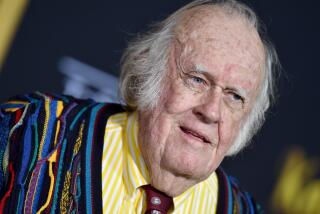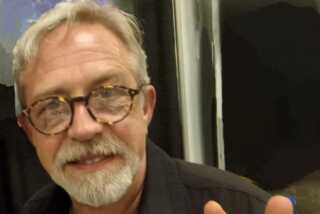Ray Harryhausen dies at 92; special-effects legend

Ray Harryhausen, best known for his stop-motion animation in “Jason and the Argonauts” and “Clash of the Titans”, has died at the age of 93.
Ray Harryhausen, the stop-motion animation legend whose work on “The Beast From 20,000 Fathoms,” “Jason and the Argonauts” and other science fiction and fantasy film classics made him a cult figure who inspired later generations of filmmakers and special-effects artists, has died. He was 92.
Harryhausen died Tuesday in London, where he had lived for decades. His death was confirmed by Kenneth Kleinberg, his longtime legal representative in the United States.
In the pre-computer-generated-imagery era in which he worked, Harryhausen used the painstaking process of making slight adjustments to the position of his three-dimensional, ball-and-socket-jointed scale models and then shooting them frame-by-frame to create the illusion of movement. Footage of his exotic beasts and creatures was later often combined with live action.
PHOTOS: Ray Harryhausen -- Career in pictures
Working with modest budgets and typically with only two or three assistants -- if any -- to keep costs down, Harryhausen created innumerable memorable big-screen moments.
In “The Beast From 20,000 Fathoms” (1953), a dinosaur thawed out by A-bomb testing in the Arctic goes on a Big Apple rampage in which it devours a New York cop before meeting its demise at Coney Island.
In “Jason and the Argonauts” (1963), the mythological hero Jason, played by Todd Armstrong, slays a seven-headed hydra guarding the Golden Fleece, then Jason and two of his men battle seven sword-wielding warrior skeletons that spring from the hydra’s scattered teeth.
In “The Valley of Gwangi” (1969), a group of turn-of-the-20th-century cowboys on horseback attempt to lasso the movie title’s namesake, a 14-foot Tyrannosaurus rex, to capture it for a Wild West show.
And who can forget the prehistoric flying reptile that scoops up and carries off Raquel Welch, clad in an animal-skin bikini, in “One Million Years BC” (1966)?
The fantasy world of Ray Harryhausen inspired Steven Spielberg, George Lucas, James Cameron and many other filmmakers, some of whom have paid cinematic homage to the special-effects maestro.
In Pixar’s 2001 animated feature “Monsters Inc.,” a Monstropolis restaurant is named after Harryhausen.
Director Robert Rodriguez’s “Spy Kids 2: Island of Lost Dreams” included a Harryhausen-inspired multiple-skeleton swordfight and a closing-credit thank you to Harryhausen.
And Lucas’ “Star Wars: Episode 2 -- Attack of the Clones” featured a gladiator-style scene, including two shots set up exactly like ones Harryhausen devised for his 1958 classic “The 7th Voyage of Sinbad.”
PHOTOS: Celebrities react to Ray Harryhausen’s death
“I had seen some other fantasy films before, but none of them had the sort of awe that the Ray Harryhausen movies had,” Lucas said in “The Harryhausen Chronicles,” a 1998 documentary written and directed by film critic and historian Richard Schickel.
In 1992, the Academy of Motion Picture Arts and Sciences presented Harryhausen with the Gordon E. Sawyer Award for technical achievement.
As part of a Hollywood contingent that wrote letters and donated money to get Harryhausen a star on the Hollywood Walk of Fame in 2003, Spielberg wrote: “Without Harryhausen’s effects work over the last five decades, there never would have been a ‘Star Wars’ or a ‘Jurassic Park.’ His films continue to set our imagination on fire.”
For Harryhausen, it all began with a giant gorilla named Kong.
Born in Los Angeles on June 29, 1920, Harryhausen was 13 when he saw “King Kong” during its run at Grauman’s Chinese Theater in Hollywood.
“I haven’t been the same since,” he is repeatedly quoted as saying over the years.
“I came out of the theater awestruck,” Harryhausen elaborated in a 1999 interview with the Chicago Tribune. “It was such a totally different, unusual film. The story line led you from the mundane world into the most outrageous fantasy that’s ever been put on the screen.”
Inspired by the landmark special effects of stop-motion animation pioneer Willis O’Brien in “King Kong,” Harryhausen began creating dinosaur models and making experimental 16-millimeter stop-motion films in the family garage.
In high school, Harryhausen discovered that a classmate’s father had worked on a film with O’Brien. The man suggested that Harryhausen call MGM and talk to his idol. He did, and to his surprise, his special-effects hero invited him to the studio.
PHOTOS: Hollywood Backlot moments
After looking at the suitcase full of dinosaur models that Harryhausen had brought with him, O’Brien suggested that he study anatomy. O’Brien later provided further constructive criticism and encouragement after viewing footage of Harryhausen’s stop-motion experiments.
While still in high school, Harryhausen enrolled in art and anatomy night classes at Los Angeles City College. To gain more knowledge of motion picture techniques, he took night classes in art direction, photography and editing at USC. The shy teenager even took an acting class.
In 1938, he met another young fantasy buff who became a lifelong friend: Forrest J Ackerman, who later became editor of Famous Monsters of Filmland magazine.
At Ackerman’s suggestion, Harryhausen began attending meetings of the Los Angeles Science Fiction League, where he met another kindred spirit who became a lifelong friend, fledgling science fiction author Ray Bradbury.
The same year, Harryhausen began his most ambitious stop-motion project in the family garage: “Evolution of the World,” a history of the world’s beginnings through the age of dinosaurs and the appearance of mammals.
He gave up the “Evolution” project in 1940 after seeing the impressive sequence showing dinosaurs and their demise in Disney’s animated feature “Fantasia,” but he used his footage and models as samples to land his first professional job: Producer-director George Pal hired him, at $16 a week, to help animate the models for the “Puppetoons,” Pal’s series of shorts for Paramount Pictures.
From 1940 to 1942, Harryhausen worked on the “Puppetoon” shorts. Then, with the world at war, he enlisted in the Army.
PHOTOS: Ray Harryhausen -- Career in pictures
Assigned to the Signal Corps, he was transferred to the Special Service Division, where, among other films, he worked on the “Why We Fight” series supervised by Col. Frank Capra.
Harryhausen, a talented artist and sculptor, also was asked by Maj. Ted Geisel, who later became famous as Dr. Seuss, to sculpt a model of the comic character Pvt. Snafu to be used as a guide for artists in the animation studio for the Army’s “Snafu” series.
After the war, Harryhausen began making a series of stop-motion animation shorts based on nursery rhymes and fairy tales, and his parents pitched in. His father helped construct the sets and made the metal armatures for the models; his mother created all the costumes and draperies for the sets.
The first four fairy tales were linked together under the title of “The Mother Goose Stories” (1946). A handful of shorts, including “The Story of Little Red Riding Hood” (1950) and “The Story of Hansel and Gretel” (1951), followed.
To earn a living while making his shorts after the war, Harryhausen took on commissions filming inserts and making TV commercials for companies and organizations.
His big break came when his mentor, O’Brien, gave him his first feature-film assignment -- to work with him on stop-motion animation effects for a film featuring another giant ape: “Mighty Joe Young.”
Harryhausen later said he animated more than 90% of the 1949 classic, whose numerous stop-motion highlights include a tug-of-war sequence between Joe and eight strongmen. The movie won technical creator O’Brien an Academy Award for special effects.
Striking out on his own, Harryhausen’s first solo stop-motion effort was the low-budget 1953 film “The Beast From 20,000 Fathoms.”
Harryhausen launched his three-decade partnership with producer Charles H. Schneer with “It Came From Beneath the Sea,” a 1955 film about a giant octopus that destroys the Golden Gate Bridge.
To distinguish Harryhausen’s brand of three-dimensional model animation process from animated cartoons and help sell their pictures to the public, Schneer came up with the name “Dynamation.”
Other special-effects showcases for Harryhausen’s work followed, such as “The 7th Voyage of Sinbad,” “The 3 Worlds of Gulliver” (1960), “Mysterious Island” (1961), “First Men in the Moon” (1964), “The Golden Voyage of Sinbad” (1974) and “Sinbad and the Eye of the Tiger” (1977).
PHOTOS: Notable deaths of 2013
Of his feature work, Harryhausen told the gathering of fans at the 2004 motion picture academy tribute: “Nine-tenths of what you see on the screen of all our professional films is the first take. I sometimes wanted to do another take, but we just didn’t have the money to do it.
“We never considered our films special-effects films. It was journalists who attached that handle to it. We used special effects to put on the screen things you can’t possibly photograph in the natural course of photography.”
Harryhausen’s last feature film as a visual-effects creator was “Clash of the Titans” (1981), a large-scale retelling of the Perseus myth, with Laurence Olivier as Zeus and Harry Hamlin as Perseus.
By then, however, stop-motion animation was viewed by many as being quaint. Indeed, a reviewer for Variety deemed the movie “an unbearable bore” with “flat, outdated special effects.”
Of today’s more-convincing, computerized special effects, Harryhausen told the New York Times in 1998: “I don’t think you want to make it quite real. Stop motion, to me, gives that added value of a dream world.”
In 2004, Billboard Books published “Ray Harryhausen: An Animated Life,” a coffee-table-tome memoir written by Harryhausen and British film historian Tony Dalton.
“Some people think it’s childish to do what I’ve done for a living,” Harryhausen told the Toronto Sun at the time. “But I think it’s wrong when you grow to be an adult to discard your sense of wonder.”
Harryhausen’s survivors include his wife of 50 years, Diana, and a daughter, Vanessa.
McLellan is a former Times staff writer.
More to Read
Start your day right
Sign up for Essential California for the L.A. Times biggest news, features and recommendations in your inbox six days a week.
You may occasionally receive promotional content from the Los Angeles Times.






